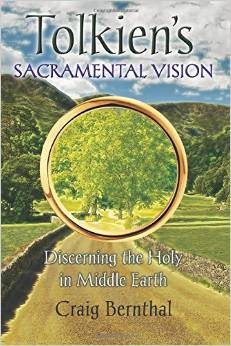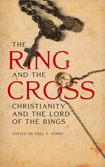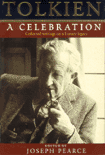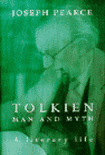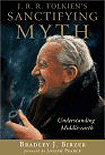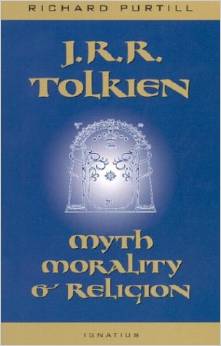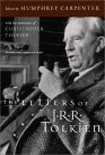- Tolkien's Faith | An Interview with Paul E. Kerry, editor of The Ring and the Cross: Christianity and The Lord of the Rings | by Sean McGuire | Ignatius Insight | May 23, 2011.
- Meeting Professor Tolkien, by Clyde S. Kilby. An American professor spent a summer with Tolkien. He remembers the man, his faith, and his writings. Christian History April 1, 2003.
- Tolkien: Man Behind the Myth At odds with his age, he created another. Christian History April 1, 2003.
Selected Articles on J.R.R. Tolkien's Lord of the Rings
- The Generosity of Tolkien, by John Zmirak. InsideCatholic.com. January 27, 20010.
- Why Fantasy? - From the Introduction to Lord of the Elves and Eldils: Fantasy and Philosophy in C.S. Lewis and J.R.R. Tolkien, by Richard Purtill (Ignatius Press, 2007).
- The Presence of Christ in The Lord of the Rings, by Peter Kreeft. Excerpted from his new book The Philosophy of Tolkien: The Worldview behind The Lord of the Rings (Ignatius Press, 2005).
- "Truth and Myth: Unlocking the Lord of the Rings" Gheens Lectures. Southern Baptist Theological Seminary. Oct. 19, 2005.
- "Creator, Creation and Creativity: Understanding Tolkien's and Lewis' Philosophy of Myth" [.MP3 audio format]. Gheens Lectures. Southern Baptist Theological Seminary. Oct. 20, 2005
- Forum with Joseph Pearce, Russell D. Moore, James Parker, and Jim Orrick--Part 1. Oct. 21, 2005. [MP3]
- Forum with Joseph Pearce, Russell D. Moore, James Parker, and Jim Orrick--Part 2 Oct. 21, 2005. [MP3]
- Joseph Pearce RESURRECTING MYTH: A Response to Dr Murphy's "Response", by Joseph Pearce. Saint Austin Review, Jan/Feb 2003. Written in response to an article published in the Nicaraguan Academic Journal attacking Joseph Pearce's Christian reading of The Lord of the Rings. . . . Mr Pearce's riposte is published here as an exposition of the Christian response to the agnostic "dumbing down" of Tolkien's Catholic mysticism.
- The Passion According to Tolkien, by Sean McGrath. Originally appeared in the magazine Desert Call: Contemplative Christianity and Vital Culture, published by the Spiritual Life Institute.
- Sacramental Imagination: Catholicism anchored Tolkien's life and suffused his writings, by Thomas Howard. Christian History Sept. 29, 2003.
- J.R.R. Tolkien's Sanctifying Myth. Bradley Birzer on the Religious Symbolism Behind "Lord of the Rings". Zenit.org. August 29, 2003.
- The Universe According to Tolkien, by Sandra Miesel. CRISIS Magazine Feb. 1, 2003.
- A Catholic Poem in Time of War: The Lord of the Rings, by Ken Craven.
- The Fellowship Of The Ring: J.R.R. Tolkien, Catholicism, and the Use of Allegory, by David Lord Alton. Text of a lecture given by David (Lord) Alton at the Catholic Society of Bath University and Bath Spa University College on Thursday 20th of February 2003.
- Scandal in the Church: Tolkien’s Response, by Nicole Stallworth. J.R.R. Tolkien addressed the problems of scandal, faith and despair in both his letters and his fiction. Catholic Exchange January 24, 2003.
- Why Tolkien Says The Lord of the Rings Is Catholic, by Joseph Pearce. National Catholic Register (January 12-19, 2003).
- The 'Ring' and the remnants of the West, by Spengler. Asia Times January 11, 2003.
- The Truth Beyond Memory: What lies behind the Fellowship, John J. Miller. National Review Online, Dec. 18, 2002.
- The Heroes of Middle-Earth: J. R. R. Tolkien & the Marks of Christian Heroism, by Leon J. Podles. Touchstone January/February 2002.
- The Distant Mirror of Middle-Earth: The Sacramental Vision of J. R. R. Tolkien, by C. N. Sue Abromaitis. Touchstone January/February 2002.
- The Writer of Our Story: Divine Providence in The Lord of the Rings, by David Mills. Touchstone January/February 2002.
- Rings of Love: J. R. R. Tolkien & the Four Loves, by Dale Nelson. Touchstone January/February 2002.
- The Lord & Lady of the Rings: The Hidden Presence of Tolkien’s Catholicism in The Lord of the Rings, by Stratford Caldecott.
- The Lord & Lady of the Rings: The Hidden Presence of Tolkien's Catholicism in The Lord of the Rings, by Stratford Caldecott. Touchstone magazine, January-February 2002.
- In Middle Earth, interview with the American professor & scholar Thomas Howard. Edited by Michael Waldstein & Fabrizio Begossi. Traces, February, 2002.
- The Truth Beyond Memory, by John J. Miller. National Review Dec. 31, 2001.
- "J.R.R. Tolkien¥s Take on the Truth" Interview with Joseph Pierce. Zenit News Service. Nov. 15, 2001.
- Tolkien's Catholic Imagination, by Jason Boffetti. CRISIS Magazine, Nov. 2001.
- The Christian Gifts of J.R.R. Tolkien, by Bradley J. Birzer. New Oxford Review, Nov. 2001.
- Tolkien: Truth & Myth, by Joseph Pearce. Lay Witness (September 2001).
- Tolkien's The Lord of the Rings: A Trilogy of Total Consecration, by Helen Valois. Immaculata Magazine, Mar/Apr 2000.
- Remembering J.R.R. Tolkien, by Theresa Carson. Catholic Heritage September/October 1998.
- J.R.R. Tolkien: Lord of the Imagination and The Fairy-Tale Maker, taken from the December 9, 1994 and December 16, 1994 issue of The Irish Family.
- J.R.R. Tolkein: Lover of the Logos, by Mark Sebanc. Communio: International Catholic Review Spring 1993.
- Tolkien the Catholic, The Lord of the Rings, and Peter Jackson's film trilogy, by Steven D. Greydanus. Tolkien: Archetype & Word, by Patrick Grant. CrossCurrents Winter 1973.
- Gazing upon Everlasting Day: Tolkien's Lord of the Rings: A Christian Classic Revisited, by Ralph C. Wood.
|


